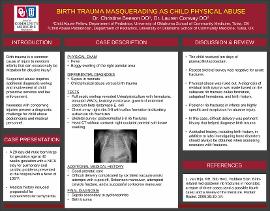| dc.description.abstract | INTRODUCTION: Birth trauma is a common cause of injury to newborn infants. In a minority of infants, birth trauma is mistaken for abusive injury. Suspected abuse requires additional diagnostic workup and involvement of child protective services and law enforcement. Neonates with concerning injuries present a diagnostic challenge for child abuse pediatricians and medical personnel.
CASE DESCRIPTION: A 29-day-old male born large for gestation age at 40 weeks gestation with a NICU stay for pulmonary and cardiac problems presented to the hospital with a fever of 105°F. Medical history included propranolol for supraventricular tachycardia. Physical exam indicated boggy swelling of the right parietal area. Septic workup included urinalysis which showed hematuria, elevated white blood cells, leukocyte esterase, and growth of extended spectrum beta lactamase E. coli, confirming sepsis secondary to pyelonephritis. X-ray imaging found right ribs 5-8 with callus formation indicating subacute (>10 days old) rib fractures, resulting in a child abuse pediatrics consult. A skeletal survey showed right posteromedial 5-8 rib fractures. Head CT without contrast showed right occipital parietal soft tissue swelling. Bone mineralization appeared normal, and metabolic bone mineralization workup including osteogenesis imperfecta labs (COL1A1 and COL2A1) was negative. Investigating the birth history revealed good prenatal care but a difficult delivery complicated by six failed vacuum-assist attempts with a pop off, Robertson maneuver, attempted clavicle fracture, and an ultimately successful corkscrew maneuver. Physical abuse was ruled out and a diagnosis of residual birth trauma was made based on the subacute rib fracture callus formation, subgaleal hematoma, and birth history. He completed ten days of piperacillin/tazobactam with complete resolution of pyelonephritis. Repeat skeletal survey was negative for acute fractures.
DISCUSSION: Posterior rib fractures in infants are highly specific and suspicious for abusive injury; however, other causes must be considered when rib fractures are discovered, including birth trauma. Neonatal fractures from routine deliveries are well-documented in the literature, especially in large neonates or with shoulder dystocia. In this case, difficult delivery including shoulder dystocia was pertinent history that aided in the diagnosis of birth trauma. It is imperative that physicians take a detailed history, including birth history, even when the presenting symptom appears not to be directly related. Labs investigating bone development disorders should be obtained when assessing neonatal fractures. The obstetric history in this case led to the retention of a family and spared them unnecessary involvement with law enforcement and child protective services. | en_US |
